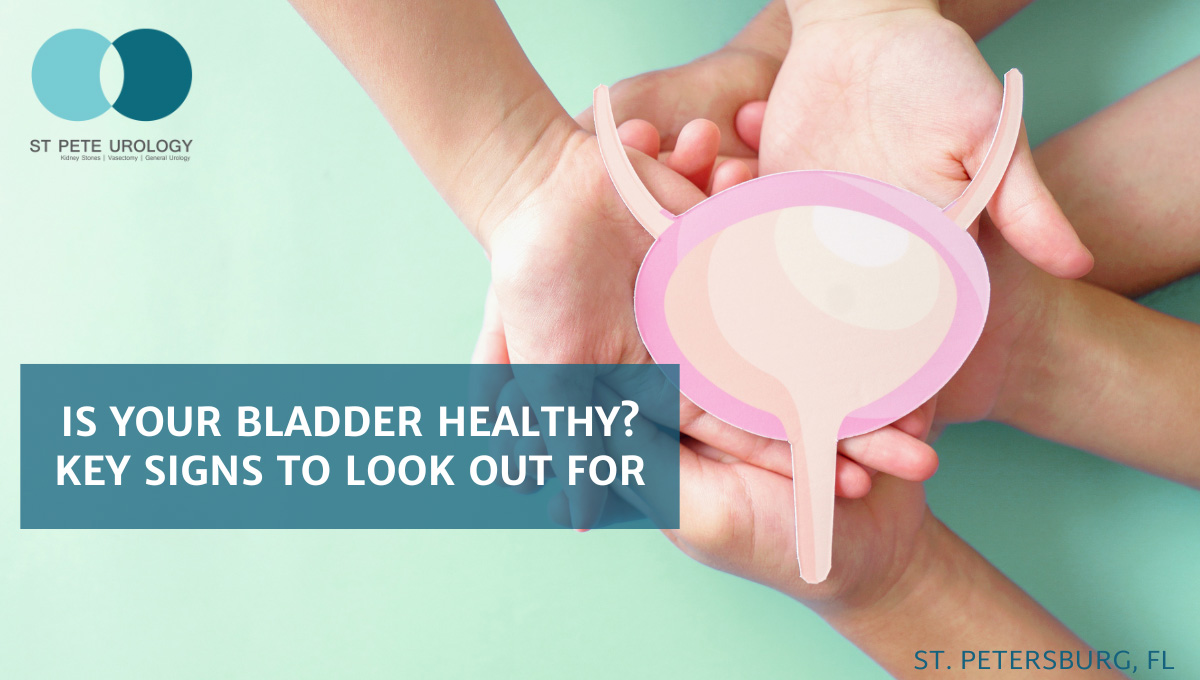Recent findings have provided a substantial link between diabetes and urological disorders. Learn about managing diabetes to improve your urological health.
Continue readingUnderstanding and Managing Urinary Tract Infections in the Elderly
Effectively managing urinary tract infections in the elderly is crucial for their well-being. Learn more about UTIs here at St Pete Urology.
Continue readingIs Your Bladder Healthy? Key Signs to Look Out For
Recognizing the key signs of a healthy bladder is important to monitor its condition and seek medical advice when necessary.
Continue readingThe Role of Diet in UTI Prevention and Treatment
3 Key Takeaways:
- Diet can play a role in UTI prevention and treatment by reducing exposure to UTI-causing bacteria, changing the pH of urine, flushing out bacteria, preventing bacteria from attaching to cells, and adding good bacteria to the urinary tract.
- Eating a vegetarian diet, drinking plenty of fluids, eating foods rich in vitamin C, and eating berries can help protect against UTIs.
- Avoiding sugary foods, bladder irritants, acidic fruits, and animal meats can reduce the risk of UTIs and improve recovery.
Do you already have a urinary tract infection (UTI)?


Can reduce exposure to UTI-causing bacteria
Some foods are reservoirs of UTI-causing bacteria while others are not. For example, pork, poultry, and other types of animal meat are reservoirs of the bacterial strains of Escherichia coli (E. coli) called extra-intestinal pathogenic E. coli (ExPEC). ExPEC are known to be responsible for over 70 percent of all UTIs. Therefore, when you regularly eat foods that contain ExPEC, you increase your risk of UTIs. On the contrary, plant-based foods do not often contain these bacteria. Hence, a vegetarian diet helps you avoid contact with these bacteria and protects you against new or recurrent UTIs.
Can change the pH of the urinary tract
For you to have a UTI, bacteria from the outside or from another part of the body must reach and establish in the urinary tract. But the growth of bacteria in the tract requires a suitable pH, among other factors. Studies have shown that foods that increase the pH of urine tend to stop the growth of UTI-causing bacteria. In contrast, foods that make the urine more acidic promote the growth of these bacteria and increase the frequency of UTIs.
This is how: Studies have shown that red meat and other animal proteins contain high potential renal acid loads (PRALs). When these foods are eaten frequently, they increase the acidity of urine and encourage the growth of UTI-causing bacteria. But fruits and vegetables contain low potential renal acid loads (PRALs). So, a regular vegetarian diet makes urine less acidic, prevents the growth of bacteria, and protects against UTIs. To prevent UTI, regularly eat oranges, broccoli, tomatoes, spinach, red berries, cauliflower, grapefruits, and foods rich in vitamin C.
Can flush out bacteria from the urinary tract
Water and other fluids are powerful antidotes against UTIs. Drinking plenty of fluids, even when not thirsty, increases urinary frequency. During urination, the urine stream washes out bacteria from the urinary tract. This reduces their numbers and protects against infection. In fact, studies have shown that taking 6-8 glasses of water every day reduces the risk of UTIs by 58 percent. It also speeds up recovery from UTIs and protects against recurrent infections.
Can prevent bacteria from attaching to cells of the urinary tract
Some foods play a role in UTI prevention and treatment by stopping infectious bacteria from attaching to the walls of the urinary tract. For example, freshly-squeezed 100-percent berry juices, like cranberry and blueberry, make it impossible for Escherichia coli and other bacteria to attach to cells of the urinary tract. These berries contain compounds called proanthocyanidins, which prevent the bacteria from sticking to the lining of the urinary tract. Hence, the bacteria remain free in the tract and are easily flushed out by urine. So, by adding these berries to your diet, you lower your risk of infection, speed up your recovery from an existing UTI, and prevent recurrent infections.
Can add good bacteria to the urinary tract
UTIs can be prevented by biological means. And probiotics and fermented foods are a great way to use good bacteria to stop the growth of bad bacteria in the urinary tract. For instance, yogurt and other fermented foods, such as sauerkraut and pickles, contain Lactobacilli and Bifidobacteria. When these bacteria reach the urinary tract, they stop Escherichia coli and other infectious bacteria from growing. By enriching your diet with probiotics and fermented products, you can prevent UTIs by stopping the growth of infectious bacteria.
Can make the urinary tract favorable for growth of UTI-causing bacteria
There are certain foods that encourage the growth of Escherichia coli and other UTI-causing bacteria. And so their intake should be reduced when undergoing treatment for UTIs. For instance, taking too much sugar encourages the breeding of bacteria in the urinary tract. That’s why you need to reduce sugar consumption when undergoing treatment or avoid sugar when struggling with a recurrent UTI. Also avoid sugary cookies, candies, or sweetened beverages—substitute them with water. Likewise, potential bladder irritants should be avoided. Once they irritate the bladder, they increase lower urinary symptoms that end up creating conditions necessary for the growth of infectious bacteria. Therefore, when undergoing treatment for UTI, avoid bladder irritants such as tea, soda, alcohol, coffee, and artificially sweetened beverages. Equally, avoid spicy foods and stop eating acidic fruits, such as lemons, oranges, or limes. You can resume eating them after the infection is gone, especially to get vitamin C, which helps prevent future infections.
Want to learn more about UTIs and other urological problems? Visit the site “St Pete Urology.”
References
- “Urinary Tract Infection.” Mayo Clinic, www.mayoclinic.org/diseases-conditions/urinary-tract-infection/symptoms-causes/syc-20353447.
- “Urinary Tract Infections.” UCSF Health, www.ucsfhealth.org/en/conditions/urinary-tract-infections.
- “Urinary Tract Infection.” Mayo Clinic, www.mayoclinic.org/diseases-conditions/urinary-tract-infection/diagnosis-treatment/drc-20353453
“How to Prevent UTI.” Healthline, https://www.healthline.com/health/how-to-prevent-uti.
Why do I get recurring urinary tract infections?


Urethritis is an infection of the urethra. It occurs when bacteria reaches the urethra and multiply there without progressing to deeper parts of the urinary tract. Cystitis is an infection of the bladder, which results when bacteria enter via the urethra and move into the bladder where it multiplies and causes disease.
Pyelonephritis is an infection of the kidney. It is triggered by the backward flow of infected urine from the bladder into the kidneys. But it can also be due to an infection in the bloodstream that ultimately reaches the kidneys.
Most urinary tract infections resolve without treatment. However, a number of them require antibiotic treatment. When a urinary tract infection reappears 2 or more times within 6 months, it is said to be recurrent. A recurrent UTI may also be an infection that occurs at least 3 times per year. Failure to promptly and decisively treat recurrent UTIs can lead to kidney damage.
What are the causes of recurrent urinary tract infections?
- Underlying health issues
The risk of recurrent urinary tract infections increases with certain health conditions. For instance, you’re likely to have recurrent UTI if you have suppressed immunity, certain autoimmune diseases, neurological disorders, urinary stones, an enlarged prostate, or a chronic health condition like diabetes.
Also, you are more susceptible to recurrent UTI if you have had surgery on any part of your urinary tract, which produces scar tissue or an alteration in anatomy. Having a catheter and going through menopause also increase the risk of recurrent UTIs.
- Genetics
The risk of recurrent UTIs is higher if you have cells that are naturally more receptive to bacteria. A number of studies have shown that due to genetics some people have cell receptors that favor bacteria causing UTIs. For such people, it is difficult to flush out these bacteria from the urinary tract, which in turn predisposes them to recurrent bladder and kidney infections.
- Sex
Women have a higher risk of recurrent urinary tract infections than men. That’s because women have a shorter urethra than men and therefore have the urethra located nearer the vaginal opening. More bacteria reach the urethra in women and are more likely to spread to the bladder and kidneys than in men.
- Poor bathroom habits
There are a large number of bacteria in feces. And when these bacteria in stool reach the urethra, they can cause urinary tract infections. That is why bathroom habits matter. And also why, after passing stool, women should wipe the anus from the front back to minimize the risk of fecal matter or bacteria moving from the anus into the urethra.
Also, bacterial transfer to the urethra increases in a dirty, moist environment. So it is important to be clean and dry before pulling your underwear back in place after peeing or passing stool. This prevents fecal matter from landing on the underwear and spreading when the underwear moves as you walk, sit or exercise.
- Sexual activity
Bacteria tend to spread easily during sexual activity. They can spread from your partner’s finger, tongue or genitals. They can also spread from sex toys. Plus, your own bacteria can spread from the vagina, penis or anus into the urethra. Likewise, items used during sex, such as spermicides, diaphragms and condoms increase the risk of recurrent UTIs.
Practicing good hygiene before and after sexual activity—such as cleaning sex toys before and after using them—can really minimize the risk of recurrent UTIs. Passing urine soon after sexual activity also helps to flush out errant bacteria. Speaking with your doctor about alternatives to spermicides and diaphragms can equally help with recurrent urinary tract infections.
What should you do to prevent recurrent urinary tract infections?
When struggling with recurrent UTIs, speak with your doctor about it. Apart from prescribing appropriate antibiotic treatment, the doctor may refer you to a urologist—a specialist in diseases and problems of the urinary system—to better pinpoint the cause and provide the most appropriate treatment.
Besides, you can take the following steps to prevent recurrent UTIs:
- Drinking plenty of water, advisably 8-10 glasses of water per day, to help you flush out bacteria from the urinary tract.
- Going to the bathroom as soon as you feel the urge to pee as holding urine can create a favorable environment for spread and multiplication of bacteria.
- Avoiding scented products, like sprays, douches, and powders that can irritate your urethra and predispose your urinary tract to infections.
- Emptying your bladder soon after sexual activity to help you flush out errant bacteria.
- Considering vaginal estrogen therapy after menopause to help keep healthy reproductive and urinary systems.
- Using alternative contraception that does not include spermicides, diaphragm or condoms.
- Proper wiping, particularly for women and girls, after using the toilet to reduce exposure of the urethra to UTI-causing bacteria found in poop.
Patient-friendly, compassionate treatment of urological disorders
Urinary problems can be both distressing and embarrassing. You may even find it difficult to speak about them. At St Pete Urology, we offer a pleasant, empathetic urological care to enable you to speak freely about your urinary tract infections and other urological disorders in order to ensure prompt, accurate diagnosis and treatment.
For more information on recurrent urinary tract infections and other urological disorders, visit the site “St Pete Urology.”
Does your diet affect UTI?


So how does your diet affect UTI?
Plant-based diet
Studies have shown that plant-based diets lower the risk of developing urinary tract infections. In a 2020 study where 9,724 Buddhists were followed over a period of 9 years, it was reported that their vegetarian dietary pattern helped to lower their risk of UTIs by 16 percent.
But how does the vegetarian dietary pattern work? It works in two ways: by preventing bacterial growth and proliferation and by eliminating bacterial reservoirs.
Firstly, a vegetarian diet has low potential renal acid loads (PRALs). As a result, vegetables and fruits make urine less acidic and can prevent the growth of bacteria associated with UTIs.
On the contrary, red meat and other animal proteins have higher potential renal acid loads (PRALs). Therefore a regular diet rich in animal proteins leads to urine that is more acidic and that promotes urinary tract infections.
Secondly, a vegetarian diet pattern avoids foods that are reservoirs for the bacterial strains of E. coli called Extra-Intestinal Pathogenic E. coli (ExPEC). Since these bacteria account for 65-75 percent of urinary tract infections, eliminating their reservoirs prevents UTIs.
In contrast, animal meat, such as poultry and pork, are reservoirs of extra-intestinal pathogenic E. coli. And the frequent consumption of animal-based proteins increases the risk of UTIs.
Yogurt and other fermented products
Regular consumption of yogurt or other fermented dairy products reduces the risk of urinary tract infections by up to 80 percent. That’s because yogurt contains good bacteria, called live and active cultures.
When these bacteria reach your digestive and urinary tract, they crowd out and inhibit the growth of UTI-causing bacteria. The bacterial cultures in yogurt also boost immunity.
Fortunately, these bacteria are never killed by the freezing process. Instead, they only undergo a dormancy state. When eaten and restored to a warm temperature within the body, the bacteria become active and provide protection to the urinary tract.
Berries and fresh fruit juices
Frequent drinking of fresh berry juice lowers the risk of UTIs by up to 50-percent. Berries such as cranberries, raspberries, blueberries and other berries contain the phytochemical called pro-anthocyanidins, which reduces the ability of E. coli bacteria to adhere to the urinary tract walls.
Therefore, fresh berry juice makes it easier to flush out bacteria responsible for UTIs by destroying their capacity to adhere to the lining of the urinary tract. A great way of consuming large amounts of berries in your diet is through smoothies.
Foods rich in vitamin C
Foods rich in vitamin C, such as oranges, lemons, strawberries, and green leafy vegetables, help to change urine pH. The change in acidity of urine prevents bacteria from growing in urine. Vitamin C also boosts immunity and speeds healing.
Fiber-packed foods
Fiber is a critical stimulator of bowel movement. Hence, including bananas and other high-fiber foods in your diet can help you prevent UTIs by encouraging regular bowel movement and minimizing pressure on urine flow.
Increased hydration
Increased water and fluid intake is a dietary measure that prevents UTIs. In fact, drinking at least 8 glasses of water per day lowers the risk of UTIs by up to 40-percent. The high volume of water makes it more efficient to flush out bacteria from the urinary tract.
Cutting down on bladder irritants
Drinking cola soft drinks increases the risk of UTIs by at least 10-percent. According to a 1985 study that involved 225 women, beverages such as soda trigger or worsen urinary symptoms and in turn increase the risk of UTIs.
Like soda, bladder irritants, such as coffee, tea, alcohol, artificially sweetened drinks, and carbonated beverages amplify the risk of lower UT symptoms, such as urinary urgency and frequency, which increase the risk of urinary tract infections.
Timely, effective treatment of UTIs
Are you experiencing frequent urinary symptoms? Would you like a permanent solution to your recurrent urinary tract infection?
At St Pete Urology, we offer prompt, accurate diagnosis and treatment of UTIs. Our objective is to always provide proper treatment of UTIs to prevent serious complications, such as urosepsis and kidney damage, which are potentially life-threatening.
For more information on the diagnosis and treatment of urinary tract infections and other urological problems, visit the site “St Pete Urology.”
How Our Urinary Systems Age With Us


A healthy urinary system works to filter blood and to remove toxins and wastes produced in the body through urine. It also helps to maintain the balance of water, minerals and salts in your blood. Plus, it enables your body to make red cells and regulate blood pressure.
By removing wastes and toxins and regulating fluids and electrolytes, the urinary system helps the body regulate itself and work properly. That is why it’s essential to protect your urinary health as a way of improving your overall health as you age.
In fact, if you take common sense steps early in life to protect your urinary health it will significantly contribute to good overall health later in life especially after the age of 40 years.
So how does your urinary system age with you?
- Kidneys
The number of cells in your kidneys decrease once you’re 40 years or older. This results in thickening of the connective tissue capsule surrounding the kidney and a reduction in the thickness of the cortical region.
The loss of cells causes loss in glomeruli function. And because the glomeruli are responsible for filtration, loss of function of the glomeruli leads to a natural yet gradual decline of kidney function.
Between the ages of 30 and 40 years, the rate of filtration in your kidneys begins to slowly decline, the size of the kidneys begins to reduce and the arteries supplying blood to the kidneys begin to narrow. In turn, your kidneys become more susceptible to injury and kidney disease.
- Bladder
The walls of your bladder and urethra are made of smooth muscles. As you grow older, the muscle tissue weakens and becomes less elastic. In turn, the capacity of your bladder reduces, resulting in difficulty to fully evacuate during urination.
Likewise, the bladder wall generally becomes stiffer as you grow older. This reduces the bladder’s ability to hold as much urine as your younger self. And as your ability to hold urine reduces, you end up urinating more often with a higher risk of urinary tract infections.
Accidental urine leakage results from muscle weakness in the bladder and is more frequent in older people, especially women. More than 50-percent of people aged 65 and older have urinary incontinence symptoms.
By the time you are 80 years or older, bladder control may be sufficiently diminished that many find themselves waking to pass urine during the night.
Various age-related causes of urinary incontinence include:
- Weak pelvic floor muscles
- Nerve damage
- Urinary tract infections
- An enlarged prostate (in men)
The most common treatment options for urinary incontinence are surgery and targeted nerve stimulation.
Another age-related urinary system condition is bladder cancer. Though the disease is not very common, the chance of having it increases with age. In fact, over 70-percent of cases of the cancer are diagnosed in people who are 65 years or older.
Risk factors include exposure to carcinogens, tobacco smoking, and radiation. The most common symptoms are blood in urine (hematuria) and pain during urination. It is advisable to speak with a urologist if you experience these symptoms.
- Urethra
After the age of 40 years, your risk of having urinary tract infections increases due to changes in the urethra. The infections may occur when bacteria invade the urethra, multiply and spread to the upper parts of the urinary system such as bladder and kidneys.
While urinary tract infections are more commonly a concern in aging women, it can also be a problem for men. More than 50-percent of women have urinary tract infections at least once in their lifetime as opposed to just 3-percent of men.
Advancing age is also a factor in UTIs as a result of general immunity weakening with age. Plus, the infections may be more frequent in older people due to urinary incontinence and retention. When not treated promptly, infections that begin in the urethra can in some cases lead to kidney infections and even sepsis.
- Prostate
The prostate is not a urinary organ; it is part of the male reproductive system. However, changes in the prostate result in problems in the urinary system. This is largely due to the prostate gland gradually enlarging after the age of 40 years and leading to extra pressure applied to the bladder, blocking urine flow.
More than 30-percent of men aged 50 years or older require treatment for an enlarged prostate (BPH) while up to 90-percent of men aged 80 years have an enlarged prostate. An enlarged prostate is not cancer, but it is associated with bothersome health issues, such as urinary tract infections, kidney infections, urinary incontinence and bladder damage.
The most common symptoms of BPH are change in urination, inability to start to pee, and a weak urine stream. Speak with your urologist about BPH symptoms as soon as they start in order to get prompt, effective treatment.
Timely urological care
To prevent age-related urinary issues, consider making regular visits to your urologist. The doctor is a specialist with the skills and experience to assess your specific symptoms, ask the right questions, make the appropriate diagnosis and find the right treatment options.
Speak with your urologist as soon as possible to get the right medications or minimally invasive treatment for relief of the symptoms. For more information on the prevention, diagnosis and treatment of urological disorders, visit the site “St Pete Urology.”
What color of pee is bad?


The color of your pee can give you a hint of what is going on in your body—and whether you are well or unwell.
Urine is made in your kidneys as your blood is filtered. The kidneys make pee to help remove toxins and other harmful substances from your blood. So your pee is not just made of water and salt but also contains wastes such as uric acid and urea, and other substances found in your blood.
What is the color of pee?
The normal color of pee is yellow because of the yellow pigment, urochrome, made in your body.
When you are healthy and adequately hydrated, you should expect to produce light yellow and close-to-clear pee.
However, lots of things can change the color of your pee.
For instance, your urine will have no color if you’re drinking a lot of water or taking diuretics drugs that enhance fluid loss.
But when dehydrated, your pee becomes amber, dark yellow to light brown.
The color of your pee also changes with the type of foods, medications, or illness.
What color of pee is bad?
- Clear
Clear urine typically indicates you’re drinking too much fluid, and you need to cut back on your water intake. Although staying hydrated is a good thing, drinking too much water can rob your body of electrolytes.
Besides, consistently clear pee may indicate that you have a liver problem, like viral hepatitis or liver cirrhosis.
If your pee is clear for a while and you’re not consuming large amounts of water, then you should see your doctor.
- Dark brown
Dark brown pee color may be due to medications, such chloroquine (Aralen) and metronidazole (Flagyl), or extreme exercise that causes muscle injury.
It may also be due to eating large quantities of aloe, rhubarb, or fava beans.
Most often, brown pee indicates you should drink more water, showing that you are dehydrated.
In some cases, brown pee results from diseases. One of them is porphyria—a rare disorder that usually involves sensitivity to light and leads to brown urine because of the breakdown of red cells.
Pee can also be brown when you have a buildup of bile, liver disease, or a tumor.
You should see a urologist if your pee is brown and doesn’t get better after a day or so.
- Cloudy
Cloudy, foamy, or frothy pee is bad and requires immediate medical help.
When urine has bubbles or foam, you may be consuming too much protein in your diet, but a persistently cloudy pee indicates a more serious condition, such as kidney disease, diverticulitis, Crohn’s disease, or other chronic condition.
Make sure to let your doctor know about it as soon as possible.
- White
Pee that is cloudy white could mean you have kidney stones or a severe infection.
The white color is probably due to the presence of pus in your urine.
Make sure to see your urologist immediately for appropriate medication.
- Pink or red
Your pee may be pink or red due to foods like blackberries, beets, rhubarb, and carrots. But red or pink color of pee may also be caused by medications like the antibiotic rifampin or phenazopyridine for urinary tract infections (UTIs).
In the worst case, pink or red pee is due to blood in urine caused by urinary tract infections, an enlarged prostate, kidney disease, a tumor, kidney stones, or cysts.
If the color change occurs together with burning pain, odd smell, or any other unusual symptoms, then it certainly means you have an underlying health problem.
So if you have red pee and have recently not eaten the foods above, then you should visit your doctor immediately for help.
- Orange
Pee that has the color of citrus-flavored soft drink may be due to medications such as high-dose vitamin B12, the antibiotic isoniazid, or the UTI drug phenazopyridine. But it can also mean you’re dehydrated or you have a problem with your bile duct or liver.
If you have orange urine in addition to light-colored stools, then bile might be reaching your bloodstream due to problems in your bile ducts or liver.
It could be a result of adult-onset jaundice.
Make sure to speak with your doctor about it.
- Blue
Blue urine is usually due to brightly colored food dyes and medications such as amitriptyline and indomethacin.
If you are not taking dyed food or these types of medications, the blue tinge may be due to bacterial infection by Pseudomonas aeruginosa or the rare condition hypercalcemia—too much calcium in your bones.
Generally, blue pee is rare and is almost often related to diet.
- Green
Your pee may be green due to vegetables in your diet.
However, green pee is usually bad as it is associated with Proteus infection.
If your pee is green, you should see your doctor, establish the source, and prescribe a course of antibiotics to clear up the urinary tract infection.
When should you see your doctor?
Speak with your doctor every time you see a change in your urine color that you can’t link to a new medication or a recent meal, particularly if the color change lasts more than a day.
Don’t hesitate to inform your doctor about it as it could signify a serious health condition.
A change in color of your pee that comes with a fever, vomiting, side or back pain, feeling very thirsty, or discharge requires urgent attention. Your doctor will run tests on your urine to determine what is going on and provide proper treatment.
What to Expect at Your First Urology Appointment


At St Pete Urology, we provide life-changing solutions for men and women with urinary tract problems and for men with issues affecting their reproductive organs. Our urologists diagnose and treat these conditions every day, so there is no need to be embarrassed about seeking help.
You should see a urologist if you have:
- Blood in your urine
- Painful urination
- Poor bladder control
- Urine leakage or flow issues
- Sudden change in the color or smell of your urine
- Pain in your groin, lower back or abdominal area
- Hernia
- Fallen bladder protrusion
- Overactive bladder (OAB)
- Low sex drive
- Recurrent urinary tract infections
- Hormone imbalance, such as low testosterone
- Kidney pain or kidney stones
- Concerns with testicles, penis or prostate
- Cancer of the bladder, penis, testicles, prostate or kidney
What should you expect during your first visit?
Whether you are referred by another doctor or find a urologist on your own, your first visit will be similar to seeing your primary care physician. The urologist will begin by reviewing your full medical history, particularly in relation to previous urological issues. The doctor will then run diagnostic tests and use the results to determine the cause and likely treatment for your condition.
Paperwork
When you arrive for your first appointment, you should expect to fill out paperwork. Depending on the reason for your visit, you may be required to complete a questionnaire. Because the questionnaire helps to evaluate your symptoms, it is advisable to track them beforehand and arrive at your appointment with specific information. Give as much detail as possible, rate the severity of your symptoms, and make a note of their timing.
Urine Sample
You will probably be asked for a urine sample during your first visit. The urine sample is analyzed in order to give the urologist an inside look at your urinary system. It helps to go to your appointment with a full bladder by drinking 16 ounces of water an hour before the appointment. If you feel the urge to empty your bladder as soon as you arrive at the urologist’s office, inform the receptionist that you are ready to provide your urine sample before you see the doctor.
Medical History
Once you are taken into the exam room, you will be asked questions about your medical history. State your symptoms clearly. Describe when they started, their timing and their severity. Be prepared with a written list of your current medications and their actual dosages, prior imaging studies, plus any over-the-counter supplements you are taking.
Physical Exam and Diagnostic Tests
Your urologist will conduct a physical examination and run diagnostic tests to determine the cause of your problem. For men, a digital rectal exam is the standard procedure to check the prostate. Other tests, such as a urethral swab, rule out sexually transmitted diseases and blood work can check the Prostate Specific Antigen (PSA) level.
If you are a woman dealing with recurring urinary tract infections (UTI), the urologist may order a urinalysis and a pelvic exam. A blood panel can determine hormone levels in women with low sex drive, and a cough stress test may indicate the cause of urinary incontinence. Computed tomography (CT) scan, magnetic resonance imaging (MRI), ultrasound, and sonography are also frequently relied on by urologists for testing.
Making an Informed Treatment Decision
After exams and diagnostic tests, the urologist will discuss with you the findings, help you understand your condition, and recommend possible solutions. At this stage, you should ask questions to be fully informed about your treatment options and their benefits and potential risks. Possible treatment options include physical therapy, medication or surgical procedures.
At St Pete Urology, we treat a full spectrum of urological conditions to help our patients overcome medical challenges and enjoy a better quality of life. Our compassionate, patient-friendly approach ensures that patients have a great experience with us from the very first visit.
No need to feel intimated or embarrassed when seeing a urologist. We see these issues every day and we are ready to help you. For more information about the diagnosis and treatment of urological problems, visit the St Pete Urology website.
The Impact of Urinary Tract Infections


Although a UTI normally is not cause for major concern, it is still important to discuss your symptoms with your doctor to receive proper treatment and make a quick recovery.
What is a UTI?
A UTI is an infection in any part of the urinary system, but most commonly it affects the bladder and the urethra. This type of UTI can cause painful urination, a frequent urge to go and cloudy or discolored urine, which can be a sign of blood in the urine. A UTI is usually caused by bacteria entering the body via the urethra. Women are more likely to get a UTI because their urethras are shorter than men’s.
What parts of the body are affected by a UTI?
Most UTIs affect the lower part of the urinary system, causing pain in the urethra and issues with the bladder. A UTI becomes more serious when it spreads to the kidneys, so it is important to seek medical treatment to keep this from occurring.
How can UTIs be prevented?


How are UTIs treated?
Your doctor may choose to prescribe antibiotics to help clear up a UTI. It is important to follow your doctor’s directions regarding the medication and to complete the full course of treatment. Pain relief medications like ibuprofen or easing discomfort with a heating pad may also be part of your treatment plan. One commonly mentioned home remedy is drinking unsweetened cranberry juice; some studies have found it can help reduce the frequency of UTIs.
Whatever treatment options you pursue, it is important to consult with your doctor regarding your symptoms if you suspect you have a UTI. The specialists at St Pete Urology are here to help you deal with both the prevention and treatment of UTIs and any other urological conditions you experience. For more information, visit the St Pete Urology website.









